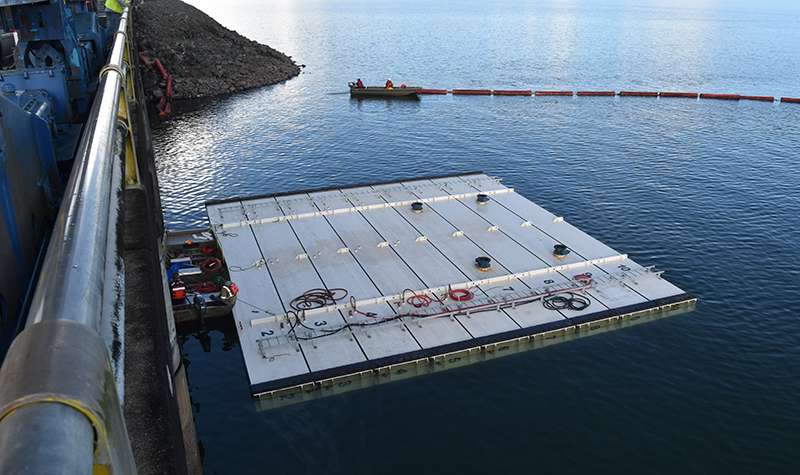Why Bulkhead on Lake Livingston Is Critical for Shoreline Protection
Wiki Article
Checking Out the Different Uses Bulkhead Frameworks in Modern Architecture
Bulkhead frameworks play a considerable duty in modern style, serving both functional and visual purposes. They can define rooms, improve storage space options, and enhance lights. In industrial setups, they serve as focal factors that reflect brand name identity - Bulkhead on Lake Livingston. Furthermore, their combination frequently sustains sound management and lasting practices. Recognizing the complete extent of their applications reveals much about contemporary design trends and user experience. What ingenious uses bulkheads might emerge in the future?Specifying Bulkhead Frameworks
Bulkhead frameworks play a critical function in modern architecture, acting as crucial parts in numerous structure layouts. These structures are generally specified as raised ceilings or systems, typically used to conceal mechanical systems, circuitry, or pipes. Bulkheads can be discovered in both domestic and industrial settings, where they offer a smooth blend of capability and appearances. Their style can integrate illumination fixtures and other attractive components, boosting the general aesthetic allure of a room.Commonly constructed from products such as wood, drywall, or steel, bulkheads can be personalized to fit the building design and demands of the structure (Bulkhead on Lake Livingston). They offer not only to conceal undesirable facilities yet likewise to create defined areas within open spaces. By taking care of the flow of a space, bulkheads add to the spatial organization, making them a significant aspect of contemporary architectural practice. Consequently, their definition encapsulates both practical and aesthetic dimensions
Useful Applications in Residential Design
Bulkhead structures play an important duty in domestic style by facilitating area optimization approaches that maximize useful areas. In addition, they add visual layout elements that improve the aesthetic appeal of living areas. On top of that, these frameworks provide vital structural assistance options, making sure the stability and safety and security of the home.Space Optimization Methods
As modern-day residential styles progressively focus on reliable use of area, cutting-edge strategies emerge to optimize functionality without compromising visual appeals. One famous method entails the assimilation of bulkhead structures, which can define locations while offering necessary storage space services. These structures can be employed to produce vertical storage space units that improve both company and access. In addition, multi-functional furnishings, such as convertible sofas and collapsible tables, matches bulkhead designs, enabling spaces to adapt to differing demands. Open floor strategies better optimize spatial circulation, motivating versatility being used. Including built-in shelving and recessed lights within bulkheads additionally adds to a streamlined setting, guaranteeing that every square inch of area is utilized effectively and harmoniously within the overall layout.Aesthetic Style Components

Architectural Assistance Solutions
In contemporary property style, an efficient architectural support option is important for keeping the stability of rooms while optimizing format and performance. Bulkhead structures play a significant function in this scenario, working as both assistance and partitioning components. They can hide mechanical systems, such as pipes and electric circuitry, while offering support to the ceiling and flooring systems. By tactically positioning bulkheads, architects can create specified locations within open layout, boosting use without compromising architectural stability. Additionally, these frameworks can suit lighting components, adding to both appearances and usefulness. To sum up, bulkhead structures are important in residential design, using flexible assistance solutions that improve both the performance and aesthetic charm of living spaces.Enhancing Visual Appeals in Business Spaces
When commercial spaces welcome innovative bulkhead structures, they not just specify physical limits yet also substantially boost the overall aesthetic appeals of the setting. These building components function as aesthetic centerpieces, drawing focus and creating a feeling of intrigue. By incorporating varied materials such as metal, wood, or glass, bulkheads can reflect a brand name's identification and goal, adding to a natural style.In addition, the calculated positioning of bulkheads can manipulate light and shadow, adding deepness and dimension to otherwise flat spaces. This interaction can change a commercial area right into an inviting atmosphere, motivating customer interaction. Additionally, the use of shade and texture in bulkhead design can evoke certain feelings, boosting the overall client experience. Ultimately, the thoughtful integration of bulkhead structures elevates the aesthetic appeal of commercial spaces, making them not just functional yet also visually charming, therefore fostering an enduring impact on site visitors.
Acoustic Efficiency and Audio Administration
Effective acoustic efficiency plays an important duty in modern architecture, particularly within business areas where sound monitoring is important. Bulkhead structures can significantly enhance acoustic qualities by taking in audio, reducing echo, and mitigating sound transfer between areas. These attributes are specifically valuable in atmospheres such as workplaces, movie theaters, and restaurants, where clear interaction and an enjoyable auditory experience are paramount.The calculated placement and design of bulkheads can aid develop sound-buffer zones, effectively separating loud areas from quieter ones. Materials utilized in bulkhead building and construction, such as acoustic panels and soft coatings, contribute to their sound-dampening capabilities. Furthermore, the consolidation of bulkheads enables for the assimilation of sound-absorbing components without endangering aesthetic appeal. By resolving acoustic performance, architects can produce unified environments that boost convenience, boost customer experience, and advertise performance, making bulkheads a crucial component in the layout of modern commercial spaces.
Integrating Bulkheads for Effective Room Use
Although frequently This Site ignored, the integration of bulkheads in building design can significantly enhance area application in modern-day buildings. These architectural components offer several practical functions, supplying a means to conceal mechanical systems, electrical wiring, and pipes without jeopardizing appearances. By tactically placing bulkheads, architects can create defined locations within open floor plans, therefore facilitating far better company and circulation.Moreover, bulkheads can include storage space remedies and lighting features, taking full advantage of the capability of or else thrown away upright area. In household setups, they might delineate zones such as cooking areas or living locations, while in industrial areas, they can enhance the effectiveness of formats by plainly noting paths and workspace.
Eventually, the thoughtful combination of bulkheads adds to an extra well organized and visually enticing environment, allowing for versatile spaces that can evolve with the needs of their occupants. This strategy not only enhances area yet also promotes a much more unified interaction in between form and feature.
Bulkheads in Public Design

Architectural Aesthetic Enhancements
While many building components goal for functionality, bulkheads in public design serve a double function by enhancing visual charm. These structures frequently develop visual passion with their style, incorporating perfectly with bordering elements. By using various materials, appearances, and colors, bulkheads can add to an unique identity for public areas, such as airports, museums, and collections. Their tactical placement helps to define locations, leading visitors while adding deepness to the general design. In addition, bulkheads can highlight lights, producing vibrant ambiences that transform throughout the day. This visual enhancement not just boosts the visitor experience however likewise fosters a local color, making bulkheads a crucial factor to consider in modern public architecture. Generally, bulkheads personify the fusion of kind Clicking Here and feature.
Architectural Assistance Solutions
As engineers look for cutting-edge ways to enhance the architectural honesty of public rooms, bulkheads become essential elements in the style and building and construction procedure. These structures provide vital assistance, particularly in areas subject to hefty foot traffic or dynamic loads. By distributing weight uniformly, bulkheads assist stop structural failure while permitting for versatile style alternatives. In big locations, such as arenas and convention centers, bulkheads are often incorporated into the general architectural structure, ensuring security and safety. Additionally, they can facilitate the unification of energies and mechanical systems, contributing to the performance of space use. Eventually, bulkheads represent a vital remedy in modern public design, strengthening both performance and security in community-focused environments.Environmental Management Procedures
Incorporating ecological security measures into public style has actually become significantly essential as metropolitan designers prioritize sustainability together with architectural assistance. Bulkhead structures offer a double objective hereof, functioning as obstacles versus erosion and flooding while simultaneously boosting the aesthetic allure of metropolitan landscapes. Their style commonly includes natural environments such as plant life, which can enhance air quality and provide environments for wildlife. Additionally, bulkheads can be engineered with absorptive products that enable for water absorption, reducing runoff and promoting groundwater recharge. This integration of environmental factors to consider not just maintains the atmosphere but likewise fosters community durability against climate modification. By making use of bulkheads efficiently, engineers add to sustainable city development that aligns with contemporary environmental objectives.Future Fads in Bulkhead Layout
Emerging patterns in bulkhead layout mirror a growing focus on sustainability, advancement, and performance in modern style. Developers are increasingly incorporating green products, such as recycled compounds and bioplastics, to decrease ecological impact. Additionally, the integration of clever technology is coming to be common, allowing bulkheads to offer multi-functional objectives, consisting of power storage space and environment control.
In metropolitan setups, modular bulkhead systems are gaining traction, offering adaptability in style and ease of installment. These systems can be adapted to different landscapes, enabling reliable space use. Additionally, visual factors to consider are progressing; bulkheads are now being designed to improve aesthetic appeal, usually including artistic components that resonate with neighborhood society.
As climate resilience comes to be a Website concern, future bulkhead styles will likely prioritize flooding protection and stormwater administration, guaranteeing architectural stability while addressing environmental challenges. This change represents an all natural technique to architecture that meets both ecological obligations and human demands.
Frequently Asked Questions
What Products Are Typically Made Use Of for Bulkhead Building?
Common products for bulkhead construction include concrete, steel, wood, and composite materials. These options offer durability, structural stability, and resistance to ecological aspects, making them suitable for different applications in building and design jobs.Exactly How Do Bulkheads Affect Structure Power Effectiveness?
Bulkheads boost building power effectiveness by giving thermal insulation and decreasing air leakage (Bulkhead on Lake Livingston). They assist maintain indoor temperature levels, therefore lowering home heating and cooling down demands, ultimately resulting in lower power expenses and enhanced environmental sustainabilityAre There Any Building Codes Specific to Bulkhead Frameworks?
Yes, constructing codes specific to bulkhead frameworks exist, varying by location. These laws commonly resolve safety and security, architectural stability, and accessibility, guaranteeing that bulkheads fulfill needed requirements for building and layout within a given jurisdiction.Can Bulkheads Be Quickly Changed or Gotten Rid Of Later?
Bulkheads can commonly be customized or eliminated, depending on their layout and building and construction. Nonetheless, such alterations may call for careful planning and adherence to building ordinance to assure structural stability and safety and security are preserved throughout the procedure.What Are the Expenses Related To Setting Up Bulkhead Structures?
The prices linked with mounting bulkhead structures can vary substantially, commonly influenced by products, design complexity, and labor. Generally, costs range from moderate to high, depending on the task's certain requirements and place.Bulkhead frameworks play an important role in modern-day design, serving as necessary parts in different building layouts. Bulkhead structures play a vital duty in household layout by helping with room optimization methods that make the most of useful areas. Often ignored, the integration of bulkheads in building design can significantly enhance area use in modern-day structures. As architects seek cutting-edge methods to enhance the architectural honesty of public spaces, bulkheads emerge as crucial elements in the style and building and construction procedure. The prices connected with setting up bulkhead structures can vary considerably, usually influenced by materials, design complexity, and labor.
Report this wiki page